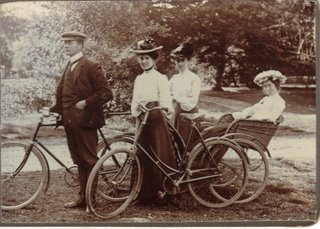This has to have been be one of the most enjoyable days I've experienced in all my years of cycling. There can't be many days in Derbyshire where it's warm for a start at 7.15am. The weather was unbelievable, with the Peak District doing a brilliant impression of Tuscany.
I was back at the Festival ground by (any bike rider will snort) 2.15pm.
55 miles ... in seven hours? What can I say? I was making a day of it. The route is (cue singing nuns) Climb every Mountain, and a largish proportion of the ride is on trackways. The dozens of people fixing punctures just makes you think that you must ride slowly, picking an optimum line, for if you charge along, you are bound to puncture.
Nor can you fly down the hills if your life depends on Weinmann centre-pull brakes. No problems with my famous Harry Hall, and its tubular tyres just might be a good idea when 'snakebite' punctures are so easily had.
So, instead of wondering what kept me, I give myself maximum marks for correct pacing. My plan for the ride was to spin along on a small gear while possible, saving my beans for the climbs, and then ride every damn one of them without getting into real difficulties. Concentrate on enjoying the day, drink the free beer at the lunch stop, and, these things put together, not ending up wilted in a patch of shade under a tree, or foaming with sweat at the stops, being treated for cramp, or being cajoled along by quite anxious riding partners. There was quite a bit of that. In quite testing conditions, I cruised round. Slowly!
I suppose all those years of club riding gives you a realistic perspective - gradually - on what is the best option. Ignore the clock, and I bossed this ride.
I was also stopping to take photographs. After the mid-point of the ride, the camera was so warm that some internal fogging blurred the lower right of the photographs. A selection follows, but first a professional shot of me crossing the Monsal Dale viaduct. Behind me, in the cool deep cutting just at the mouth of the tunnel, a glee club were singing 'Daisy, Daisy'. The brilliantly organised lunch stop was a couple of level miles ahead.
 |
| Riders on the High Peak Trail |
 |
| High Peak trail still |
 |
| Through a cutting |
 |
| Top of Beeley Moor, before the big descent |
 |
| Common spotted orchids on the Monsal Dale trail |
 |
| On the descent into Hartington |
 |
| Same road without the hallucinatory vehicle |
 |
| Top of the track up from Hartington |
The Eroica is the only mass participation ride I do. I treat it in a solipsistic fashion: the majority are far more involved in the whole event and its festival, ride in costumes (tweeds and wool socks remained popular), and with friends.
From Audax riding days, I'd tended to assume that the middle distance would be the most popular option, but in this year's tweak to the route, the middle length and short rides joined for the last couple of miles. Suddenly there was a barely-cycling army of stropping pre-teens, boys with limited bike-handling skills, and their hot and bothered parents. One concludes that, really, the short ride is the difficult one.
At the finish, I heard after a bit the name of Professor Steve Pudney announced. He's a man I've met, and whose Lands End to John O'Groats ride for charity on a bicycle precisely as old as himself I followed via his blog. He'd had his first experience as a rider of proper cycling-induced cramp, of the yelping in pain lying on the roadside kind. I suggested to him that a free gin and tonic, or at least the tonic part, might help. The young woman helping work the Hendricks Gin promotion must have been a resting actress perfecting her saucy barmaid persona, and launched into a repertoire of risque cucumber quips. I quite enjoyed watching the role reversal. Hot, bothered but very correct male trying to cope with a barrage of not totally welcome banter from a young woman. But he avoided triggering intellectual cramps and came through this unexpected ordeal as he had the physical one.


















